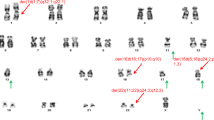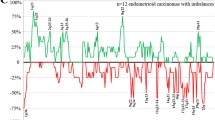Summary
Human malignant gliomas are frequently associated with loss of gonosomes and chromosomes 13, 17, and 22. Their progression from anaplastic glioma to glioblastoma is marked by additional loss of chromosome 10. In addition, structural and numerical aberrations of chromosome 7 are frequently found. We report on the karyotypes of a series of 20 human gliomas of which 11 were analysed as established cell lines; 9 cases were investigated in early culture, 5 of which later also became established lines.
In addition to the frequently reported overrepresentation of chromosome 7, four cell lines with polysomy for chromosome 22 were seen. A high incidence of structural chromosomal aberrations was present in early cultures as well as in cell lines after various in vitro passages. We found that the general characteristics of karyotypic aberrations found in early cultures or direct preparations of dispersed tumour material were reflected in the pattern of aberrations present in cell lines at much later time points. Thus it appears as if no systematic changes can be attributed to long-term cultures. Suspicious losses of chromosomes 14, 18, and 19 or gain of chromosome 22 indicate that individual cases may have originated due to other mechanisms than the ones already hypothesized, i.e., different suppressor genes or amplification of genes other than the EGF-R-gene. None of the established cell lines had a genomic rearrangement of c-erbB 1, c-erbB 2 or of the p 53 gene.
Similar content being viewed by others
References
Bigner DD, Bigner SH, Pegram CN B, Mahaley MS, Ruoslahti E, Herschman H, Eng LF, Wirkstrand CJ (1981) Heterogeneity of genotypic and phenotypic characteristics of fifteen permanent cell lines derives from human gliomas. J Neuropath Exp Neurol 40: 210–229
Bigner SH, Mark J (1984) Chromosomes and chromosomal progression of human gliomas in vivo, in vitro and in athymic nude mice. Prog Exp Tumor Res 27: 67–82
Bigner SH, Mark J, Bullard DE, Mahaley MS, Bigner DD (1986) Chromosomal evolution in malignant human gliomas starts with specific and usually numerical deviations. Cancer Genet Cytogenet 22: 121–135
Bigner SH, Wong AJ, Mark J, Muhlbaier LH, Kinzler KW, Vogelstein B, Bigner DD (1987) Relationship between gene amplification and chromosomal deviations in malignant human gliomas. Cancer Genet Cytogenet 29: 165–170
Bigner SH, Mark J, Burger PC, Mahaley MS, Bullard DE, Muhlbaier LH, Bigner DD (1988) Specific chromosomal abnormalities in malignant human gliomas. Cancer Res 88: 405–411
Davies RL, Grosse VA, Kucherlapati R, Bothwell M (1980) Genetic analysis of epidermal growth factor action: assignment of human epidermal growth factor receptor gene to chromosome 7. Proc Natl Acad Sci USA 77: 4188–4192
Deimling Av, Louis DN, Ammon Kv, Petersen I, Wiestler OD, Seizinger BR (1992) Evidence for a tumor suppressor gene on chromosome 19 q associated with human astrocytomas oligodendrogliomas and mixed gliomas. Cancer Res 52: 4277–4279
Deimling Av, Ammon Kv, Schoenfeld D, Wiestler OD, Seizinger BR, Louis DN (1993) Subsets of glioblastoma multiforme defined by molecular genetic analysis. Brain Pathol 3: 19–26
Feinberg AP, Voglestein B (1983) A technique for radiolabeling DNA restriction endonuclease fragments to high specific activity. Anal Biochem 132: 6–13
Fong CT, White PS, Pterson K, Sapienza C, Cavanee WK, Kern SE, Vogelstein B, Cantor AB, Look AT, Brodeur GM (1992) Loss of heterozygosity for chromosome 1 or 13 defines subsets of advanced neuroblastomas. Cancer Res 52: 1780–1785
Fults D, Tippets RH, Thomas GA, Nakamura Y, White R (1989) Loss of heterozygosity for loci on chromosome 17 p in human malignant astrocytoma. Cancer Res 49: 6572–6577
Fults D, Pedone CA, Thomas GA, White R (1990) Allelotype of human malignant astrocytoma. Cancer Res 50: 5784–5789
Griffin CA, Hawkins AL, Packer RJ, Rorke LB, Emanuel BS (1988) Chromosome abnormalities in pediatric brain tumors. Cancer Res 48: 175–180
Haluska FG, Tsujimoto Y, Croce CM (1987) Oncogene activation by chromosome translocation in human malignancy. Ann Rev Genet 21: 321–345
Hamel W, Westphal M, Shepard HM (1992) Proto-oncogene expression in human glioma derived cell lines. Int J Oncol 1: 637–682
Hamel W, Westphal M, Shepard HM (1993) Loss in expression of the ratinoblastoma gene product in human gliomas is associated with advanced disease. J Neurooncol, in press
Henn W, Blin N, Zang KD (1986) Polysomy of chromosome 7 is correlated with overexpression of the erbB oncogene in human glioblastoma cell lines. Hum Genet 74: 104–106
James CD, Carlbom E, Nordenskjold M, Collins P, Cavenee WK (1989) Mitotic recombination of chromosome 17 in astrocytomas. Proc Natl Acad Sci USA, 86: 2858–2862
James CD, Carlbom E, Dumanski JP, Hansen M, Nordenskjold M, Collins VP, Cavenee WK (1988) Clonal genomic alterations in glioma malignancy stages. Cancer Res 48: 5546–5551
Jansson M, Philipsen L, Vennstrom B (1983) Isolation and characterization of multiple human genes homologous to the oncogenes of avian erythroblastosis virus EMBO J 2: 561–565
Jenkins RB, Kimmel DW, Moertel CA, Schultz CG, Scheithauer BW, Kelly PJ, Dewald GW (1989) A cytogenetic study of 53 human gliomas. Cancer Genet Cytogenet 39: 253–279
Kinzler KW, Bigner SH, Bigner DD, Trent JM, Law ML, O'Brian SJ, Wong AJ, Vogelstein B (1987) Identification of an amplified highly expressed gene in a human glioma. Science 236: 70–73
Kunzmann R, Hölzel F (1987) Karyotypic alterations in human ovarian carcinoma cells during long-term cultivation and nude mouse passage. Cancer Genet Cytogenet 28: 210–212
Libermann TA, Nusbaum HR, Razon N, Kris R, Lax I, Soreq H, Whittle N, Waterfield MD, Ullrich A, Schlessinger J (1985) Amplification, enhanced expression and possible rearrangement of EGF-receptor gene in primary human brain tumors of glial origin. Nature 313: 144–147
Maniatis T, Frisch EF, Sambrock J (1982) Molecular cloning, a laboratory manual. Cold Spring Harbor Laboratory, Mass
Mark J, Westermark B, Ponten J, Hugsson R (1977) Banding patterns in human glioma cell lines. Hereditas 87: 243–260
Martuza RL, Seizinger BR, Jacoby LB, Rouleau GA, Gusella JF (1988) The molecular biology of human glial tumors. Trends Neurosci 11: 22–27
Mercer WE, Shields MT, Amin M, Sauve G, Apella E, Romano JW, Ullrich SJ (1990) Negative growth regulation in a glioblastoma tumor cell line that conditionally expresses human wildtype p 53. Proc Natl Acad Sci USA 87: 6166–6170
Mikkelsen T, Cairncross JG, Cavanee WK (1991) Genetics of the malignant progression of astrocytoma. J Cell Biochem 46: 3–8
Mitelman F (1983) Catalogue of chromosomal aberrations in cancer. Cytogenet Cell Genet 36: 1–515
Reed KC, Mann DA (1985) Rapid transfer of DNA from agarose gels to nylon membranes. Nucl Acid Res 3: 7207–7221
Rey JA, Bello MJ, de Campos JM, Kusak ME, Ramos C, Benitez J (1987) Chromosomal patterns in human malignant astrocytomas. Cancer Genet Cytogenet 29: 201–221
Rey JA, Bello MJ, de Campos JM, Kusak ME, Moreno S (1987) Chromosomal composition of a series of 22 human low-grade gliomas. Cancer Genet Cytogenet 29: 223–237
Sandberg A (1980) The chromosomes in human cancer and leukemia. Elsevier, New York
Scheres JMJC, Hustinx TWJ, Trent JM (1986) Possible involvement of unstable sites on chromosomes 7 and 14 in human cancer. Cancer Genet Cytogenet 19: 151–158
Seabright M (1971) A rapid banding technique for human chromosomes. Lancet ii: 971–972
Seizinger BR, Breakefield XO (1990) The role of “tumor suppressor” genes in neural tumors. Trends Neurosci 13: 3–6
Shapiro JR, Yung WA, Shapiro WR (1981) Isolations, karyotypes and clonal growth of heterogeneous subpopulations of human malignant gliomas. Cancer Res 41: 2349–2359
Shapiro JR (1986) Biology of gliomas: chromosomes, growth factors and oncogenes. Semin Oncol 13: 4–15
Stenman G, Rorsman F, Betsholtz C (1988) Sublocalization of the human PDGF A-chain gene to chromosome 7, Band q 11.23, by in situ hybridization. Exp Cell Res 178: 180–184
Swann DC, McBride OW, Robbins KC, Keithley DA, Reddy EP, Aaronson SA (1982) Chromosomal mapping of the simian sarcoma virus one gene analogue in human cells. Proc Natl Acad Sci USA 79: 4691–4695
Westphal M, Hänsel M, Brunken M, König A, Köppen JA, Herrmann H-D (1987) Initiation of primary cell cultures from human intracranial tumors on extracellular matrix from bovine corneal endothelial cells. Exp Cell Biol 55: 152–163
Westphal M, Hänsel M, Müller D, Laas R, Kunzmann R, Rohde E, König A, Hölzel F, Herrmann H-D (1988) Biological and karyotypic characterisation of a new cell line derived from human gliosarcoma. Cancer Res 48: 731–740
Westphal M, Hänsel M, Kunzmann R, Hölzel F, Herrmann H-D (1989) Spectrum of karyotypic aberrations in cultured human meningiomas. Cytogenet Cell Genet 52: 45–49
Westphal M, Herrmann H-D (1989) Growth factor biology and oncogene activation in human gliomas and their implications for specific therapeutic concepts. Neurosurgery 25: 681–694
Westphal M, Nausch H, Herrmann H-D (1990) Antigenic staining patterns of human glioma cultures: primary cultures, long-term cultures and cell lines. J Neurocytol 19: 466–477
Yamamoto T, Ikawa S, Akiyama T, Semba K, Nomura N, Miyajima N, Saito T, Toyoshima K (1986) Similarity of protein encoded by the human c-erb-B-2 gene to epidermal growth factor receptor. Nature 319: 230–234
Zakut-Howi R, Bienz-Tachmor B, Givol D, Oren M (1985) Human p 53 cellular antigen: c-DNA sequence and expression in cos-cells. EMBO J 4: 1251–1255
Zang KD (1982) Cytological and cytogenetic studies on human meningioma. Cancer Genet Cytogenet 6: 249–274
Author information
Authors and Affiliations
Additional information
Dedicated to Prof. Dr. H.-D. Herrmann on the occasion of his 60th birthday.
Rights and permissions
About this article
Cite this article
Westphal, M., Hänsel, M., Hamel, W. et al. Karyotype analyses of 20 human glioma cell lines. Acta neurochir 126, 17–26 (1994). https://doi.org/10.1007/BF01476489
Issue Date:
DOI: https://doi.org/10.1007/BF01476489




